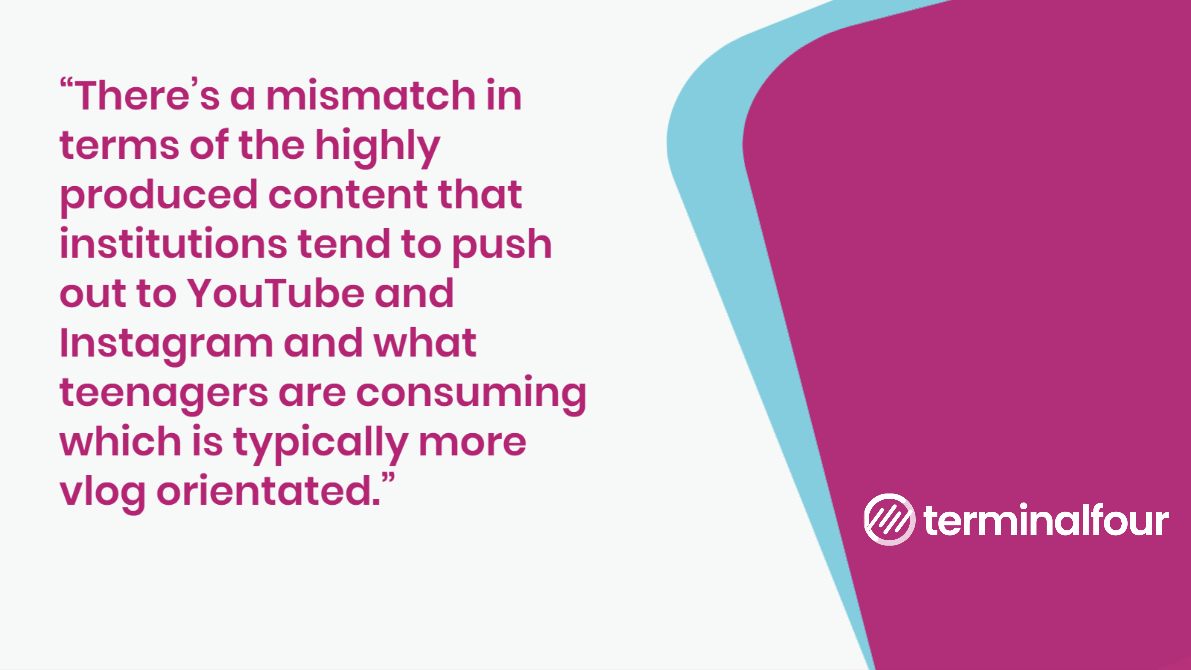Last month we hosted our first webinar of 2020 with a panel discussion featuring our founder Piero Tintori, as well as Liz Gross and Claire Gibbons.
If you missed it you can still re-run the entire webinar here. But for those short on time we've put together a five minute read that will bring you up to speed on the debate that got the HE digital, marketing, and recruitment communities talking.
The Panel - Piero, Liz, and Claire
Piero was joined by two leading thinkers in higher education, Dr. Liz Gross and Claire Gibbons.
Liz is a data-driven researcher and scholar who specializes in creating entrepreneurial social media strategies in higher education. She is also the founder and CEO of Campus Sonar, a specialized social listening agency that matches high-value social media intelligence and engagement opportunities to organizational strategic initiatives.
Claire is an external consultant to higher education institutions providing digital governance and projects consultant advice. In recent years she has transformed the operations of a number of institutions including Leeds Trinity University, Swansea University, Loughborough University, Trinity College and the University of Kent.
The panel kickstarted the discussions by covering the results from the 2019 Terminalfour Digital Marketing & Web Survey in which 413 professionals from 317 institutions across 24 countries took part. If you missed the survey results you can grab your own copy here.
The hamster wheel of university marketing and recruitment
This year we uncovered that the recruitment and retention of HE web and digital professionals have become challenging, especially for universities and colleges in larger cities where commercial organizations are drawing away specialists with potentially higher salary offerings and terms.
Dr. Liz Gross commented that "understanding the depth and breadth of the strategic marketing and digital work that's going on and the budget and staff required to achieve it is critical. Without that understanding, the ‘do-ers' will always feel like they're continually running on the hamster wheel and not having enough time to get things done."
Claire had experienced and witnessed this growing pressure. "When I wrote out all the tasks our team undertook in marketing it reached 3-4 sides of A4. You might have 20 people doing all those roles in a digital agency but in smaller institutions, it could land on the plate of three to four people. It's important to raise the profile of the work marketing do within your institution so that you get the recognition and support required."
.png)
Governance takes center stage
The desire to run more professional web & digital teams have increased over the past number of years and the strongest trend is a continued move from decentralized to centralized web and digital management structures.
The development of governance structures, adoption of standards and the use of design systems are also being deployed by high performing Higher Education teams.
The panel had a useful discussion about governance structures, policies, and procedures. Claire Gibbons commented that "three years ago, people would literally have had no idea what governance structures were, but now there is a recognition that institutions need these kinds of frameworks."
"Universities are moving towards an era where there is increased visibility and professionalization of digital and marketing teams that have a greater focus on governance structures.
In the UK .Gov has really set the bar high in publishing their governance frameworks and universities are beginning to move to a similar approach with institutions like the University of St Andrews leading the way."

Universities have been reluctant to move from highly produced brand storytelling to a real-life view of the campus
The panel debated approaches to social media. Liz Gross had lots of insights on the topic.
"There's a mismatch in terms of the highly produced content that institutions tend to push out to YouTube and Instagram and what teenagers are consuming which is typically more vlog orientated.
In response to this, it seems that some institutions that combine highly produced video content, as well as more raw natural content, are reaping the benefits.
Colorado State University is an institution that is achieving great things with these tactics. They are hiring and paying student bloggers to promote their own thoughts on the university without censoring them. West Virginina University and Temple University similarly are having success with this approach using YouTube and are cross promoting student ambassador accounts (Instagram and YouTube handles) through their university channels," added Liz.

Institutions are shifting their social media prioritization
Claire Gibbons continued the discussion on social media.
"I think the idea that Instagram is going to overtake Facebook as a platform is sensible and I think it is in line with the research that came out from Terminalfour.
Jumping to the measurement of social media success, many cited Facebook as contributing most significantly still in terms of conversions. Yet when people talk about where they're seeing the most engagement and where they'll focus their time in the coming year, they talk about Instagram. So perhaps institutions are anticipating a shift in user behavior and outcomes and where they spend their time.
For people approaching the end of school, often they aren't Facebook users but their parents and supporters may be, so it remains a viable channel. Parents are hugely important in terms of university decision-making."
Liz joined in the debate. "Clearly there is a shift towards Instagram as a channel. And in terms of new emerging social networks, people should be listening and observing and determining what's on these social media ecosystems like TikTok and other platforms.
Some institutions jump onto a new platform and then launch content at risk. I think that could be avoided by taking a listening first approach. But there should always be some budget dedicated to experimental marketing activity to try and test out new content and channels, concluded Liz.

Our Top 5 Take-Aways
- Set out the business case to get more people in your team when you need it. It's not typically possible to resource up internally to deliver every activity that's required for HE marketing. Draw up a list of all workstreams and activity, identify the gaps and your preference and justification for resourcing internally versus using external suppliers.
- Avoid feeling isolated. There is an active and engaging community of marketing, digital and recruitment experts in higher education. Join the HE Slack and Facebook groups for support, ideas and to get different views on your specific challenges.
- Recruitment and retention of digital and marketing expertise are not necessarily strictly tied to monetary factors. It's the ability to have a flexible work environment, the option to work from home occasionally without questioning whether or not they're actually working, and having support available for professional development. These factors matter and combine to create a value proposition.
- The social media landscape remains complex for universities. Institutions are shifting their social media prioritization to Instagram but it hasn't yet proven to be effective at driving conversions. However, for brand building purposes institutions using both highly produced content and real-live storytelling through the eyes of student ambassadors are beginning to see the benefits of this hybrid approach.
- Set aside an experimentation budget to try out new types of content and to research new social media channels such as TikTok.
It was a fascinating panel discussion and thank you to everyone involved and the community who logged in and contributed to the debate.

:format()//media/webinar-synopsis.png)

